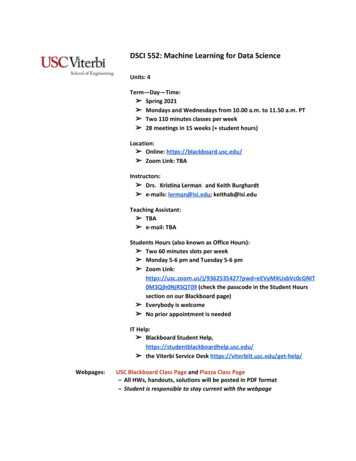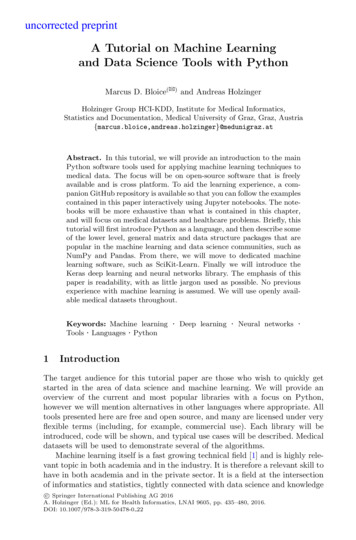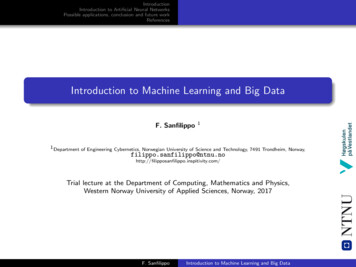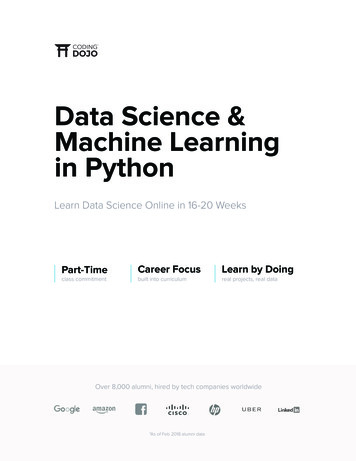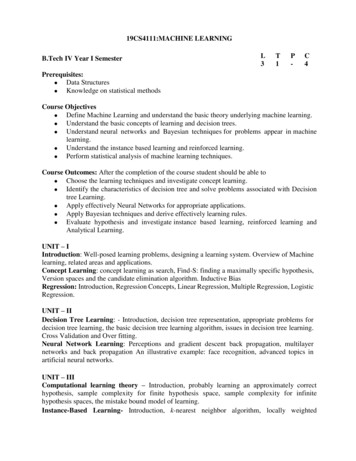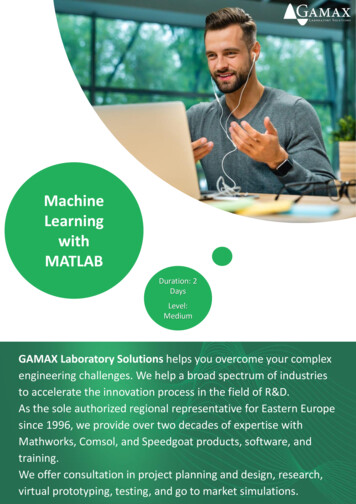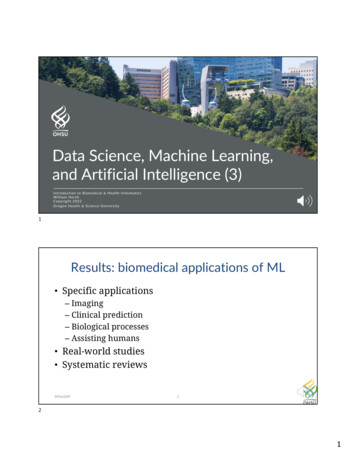
Transcription
Data Science, Machine Learning,and Artificial Intelligence (3)Introduction to Biomedical & Health InformaticsWilliam HershCopyright 2022Oregon Health & Science University1Results: biomedical applications of ML Specific applications– Imaging– Clinical prediction– Biological processes– Assisting humans Real-world studies Systematic reviewsWhatIs09221
Imaging Early studies Diabetic retinopathy (DR)(Gulshan, 2016; Ting, 2017) Histology of cancer (Bejnordi,2017) and metastases (Veta,2019) Tuberculosis (Lakhani, 2017)and pneumonia (Rajpurkar,2018) Skin cancer (Esteva, 2017;Haenssle, 2018; Tschandi, 2019) State of the art (Esteva, 2021)WhatIs0933Systematic review and meta-analysis of imaging(Liu, 2019) Evaluated diagnostic accuracy of deep learning algorithms versushealthcare professionals in classifying diseases using medicalimaging 69 studies with enough data to construct contingency tables– Sensitivity from 9.7% to 100% (mean 79.1%)– Specificity from 38.9% to 100% (mean 88.3%) Out-of-sample external validation done in 25 studies, of which 14made comparison between deep learning models and healthcareprofessionals in same sample– Pooled sensitivity of 87.0% for deep learning models vs. 86.4% forhealthcare professionals– Pooled specificity of 92.5% for deep learning models and 90.5% forhealthcare professionalsWhatIs09442
Some more recent imaging studies Clinically acceptable performance in African settingfor detecting referable DR, vision-threatening DR, anddiabetic macular edema in population-based DRscreening (Bellemo, 2019) Deep learning predicted cardiovascular disease risksfrom lung cancer screening low-dose computedtomography (Chao, 2021) Gleason grading for prostate cancer comparable topathologists (Bulten, 2022)WhatIs0955Other pattern-recognition areas Wave forms – use of ECGs– Age and sex determination (Attia, 2019)– Cardiac arrhythmia detection comparable to cardiologists(Hannun, 2019)– Interpretation better than conventional algorithm (Smith,2019; Hughes, 2021)– Detecting hyperkalemia from 2 (of 12) leads (Galloway,2019)– Early diagnosis of low ejection fraction in patients insetting of routine primary care (Yao, 2021) Sounds– Detecting pathological breath sounds in children withdigital stethoscopes (Kevat, 2020; Zhang, 2021) Mobile devices– Detect anemia from smartphone pictures (Mannino, 2018)WhatIs09663
Clinical prediction Length of stay, mortality, readmission, and diagnosis at two large medical centers(Rajkomar, 2018)30-day readmission in heart failure (Golas, 2018)ML-selected variables outperformed expert-selected variables in predicting patientmortality from coronary artery disease (Steele, 2018)Age and sex determination from retinal images (Poplin, 2018)Early risk of chronic kidney disease in patients with diabetes (Ravizza, 2019)Wide variety of pediatric diagnoses from EHR data at major referral center (Liang,2019)Dementia from EHR data up to two years before clinical diagnosis (Wang, 2019)Predict childhood lead poisoning (Potash, 2020)Improve accuracy of patient deterioration predictions (Romero-Brufau, 2021)Prediction models for mechanical ventilation, renal replacement therapy, andreadmission in COVID-19 (Rodriguez, 2021)WhatIs0977Biological processes Genomics––––Predicting clinical outcomes from cancer genomic profiles (Yousefi, 2017)Calling gene variants in sequencing data (Poplin, 2019)Identifying facial phenotypes of genetic disorders (Gurovich, 2019)Prioritizing and classifying gene variants in sequencing data (Nicora, 2022) Drug discovery– Discovery of existing and new drugs effective as antibiotics (Das, 2021)– Other discovery of new drugs (Xiong, 2021; Jayatunga, 2022) Protein folding prediction– Recent unprecedented success in predicting protein structure from aminoacid sequence (Jumper, 2021; Varadi, 2022; Al-Janabi, 2022)WhatIs09884
Assisting humans Automatically charting symptoms from patient-physician conversations (Rajkomar,2019)“Weakly supervised” (using clinical diagnoses) interpretation of pathology slideswould allow pathologists to exclude 65–75% of slides while retaining 100% sensitivity(Campanella, 2019)Learning outlier clinical alerts to reduce drug prescribing errors and adverse events(Segal, 2019)– 85% confirmed clinically valid, 80% considered clinically useful– Alert burden low – 0.4% of all medication orders Assisting dermatologists improved accuracy but poor ML worsened humanperformance (Tschandl, 2020)Commercially available AI algorithm assessed screening mammograms withsufficient diagnostic performance to be further evaluated as an independent reader inprospective clinical trials (Salim, 2020)– Combining first readers with best algorithm identified more cases positive for cancer thancombining first readers with second readersWhatIs0999Assisting humans (cont.) Aiding radiologists– In breast ultrasound, reduced false-positive rates by 37.3% and requested biopsiesby 27.8% while maintaining same level of sensitivity (Shen, 2021)– In interpreting CXRs, increased sensitivity for junior radiologists and specificity forsenior radiologists (Homayounieh, 2021)– In fracture assessment, improved sensitivity without increasing reading time(Guermazi, 2022) AI system helped physicians extract relevant patient information in a shortertime while maintaining high accuracy (Chi, 2021) AI assistance associated with improved dermatology diagnoses by PCPs andNPs for 1 in every 8 to 10 cases (Jain, 2021) Identify features in CDS medication alerts to reduce volume by half while stillmaintaining 99% sensitivity (Liu, 2022) Feedback by AI tutoring system led to better surgical training for medicalstudents than virtual expert instruction (Fazlollahi, 2022)WhatIs0910105
Real-world studies Eye diseases– Diagnosis and treatment decisions for congenital cataracts High accuracy for diagnosis (98%), risk stratification (93-100%), and treatmentsuggestions (93%) (Long, 2017) Accuracy for diagnosis and treatment determination were 87.4% and 70.8%, whichwere significantly lower than 99.1% and 96.7% than senior consultants but took lesstime (2.79 min vs. 8.53 min) (Lin, 2019)– Detect previously undiagnosed DR at primary care clinics (Abràmoff, 2018) Sensitivity 87.2%, specificity 90.7%, imageability rate 96.1%– Use for DR in rural India (Gulshan, 2019) Sensitivity 88.9%, specificity 92.2%, comparable to manual grading– Use for DR in smartphone (Natarajan, 2019) Images from 18 of 231 were deemed ungradable For rest, sensitivity and specificity of referable DR were 100.0% and 88.4%WhatIs091111Real-world studies (cont.) Algorithm-assisted pathologists demonstrated higher accuracy than either thedeep learning algorithm or pathologist alone (Steiner, 2018)– Assistance significantly increased sensitivity of detection for micrometastases(91% vs. 83% alone)– Reduced time compared to pathologist alone for positive (61 vs. 116 sec) andnegative images (111 vs. 137 sec) In GI endoscopy– Predicted pathology of detected diminutive colonic polyps ( 5 mm) on basis ofreal-time comparison with pathologic diagnosis of resected specimen (goldstandard) to “detect and leave” (Mori, 2018) Negative predictive value 94%– Colonic adenoma detection rate improved from 20-30% to 50%, althoughadditional polyps mostly small and benign (Wang, 2019)– ML system better able to detect blind spots in upper endoscopy (EGD) than humanendoscopists (Wu, 2019)WhatIs0912126
Real-world studies (cont.) Other clinical settings– Sepsis surveillance reduced in-hospital mortality and length ofstay (Shimabukuro, 2017)– Prospective validation of predicting 180-day mortality inoutpatients with cancer (Manz, 2020), shown to improvenumber of serious illness conversations with patients (Manz,2020)– Low agreement among clinicians and ML system in outpatienttriage decisions (Entezarjou, 2020)– Improved diagnosis of COVID-19 in chest x-rays (Rangarajan,2021)WhatIs091313Systematic review of interventions using AIclinical prediction tools (Zhou, 2021) Zhou, Q., Chen, Z.-H., Cao, Y.-H., Peng, S., 2021. Clinical impactand quality of randomized controlled trials involvinginterventions evaluating artificial intelligence prediction tools:a systematic review. NPJ Digit Med 4, 154.https://doi.org/10.1038/s41746-021-00524-2 Review of all randomized controlled trials (RCTs) using– Traditional statistical (TS) – mostly regression– Machine learning (ML) – all but deep learning– Deep learning (DL) – neural networks TS and ML tools focused on assistive treatment decisions,assistive diagnosis, and risk stratification, whereas DL toolsonly focused on assistive diagnosisWhatIs0914147
65 RCTs from 26K publications – notuncommonWhatIs091515Identified 65 RCTs with following characteristics 61.5% positive results Variety of disease categories – cancer, other chronic disease, acute disease, andprimary care Types of algorithms – TS ML DL Predictive tool function – assistive treatment decisions assistive diagnosis riskstratificationSome concerns of bias in studies One-third no sample size estimation Three-fourths no masking (open-label) Majority did not reference CONSORT, use intent-to-treat analysis, or provide studyprotocol Caveat: number of positive studies does not necessarily indicate generalsuperiority of methodsWhatIs0916168
Proportion of trials and results for Low risk of bias – a-b Some concerns – c-d High risk of bias – e-fFor low risk of bias trials, positiveoutcomes in TS 63%, ML 25%, DL 80%WhatIs091717Characteristics by tool type varied Model input – clinical quantitativedata for TS/ML, images for DL Disease category – varied forTS, chronic disease for ML,cancer for DL Tool function – risk stratificationand treatment for TS, treatmentfor ML, diagnosis for DL Results – mixed for TS, morepositive for ML/DLWhatIs0918189
By publication year Increasing per year Increasing DL per year Comparable rates of positivityBy tool type, more positive for DL ML TSWhatIs091919Characteristics of DL trials Of 11 RCTs, 9 evaluate assisting endoscopy – all positiveresults 2 other RCTs have negative resultsWhatIs09202010
Conclusions about review AI predictive tools show great promise in improving clinicaldecisions for diagnosis, treatment, and risk stratification butcomprehensive evidence lacking– Number of clinical trials assessing clinical benefit is small– Majority of the clinical trials have indeterminate or high risk of bias– Trials of deep learning methods highly focused on endoscopic procedures Concerns about review– Missing column in Table 2 of DL interventions Does not include Yao (2021) – published after review done?– Difficult to use data in Supp Table 4 of ML interventions Includes Wijnberge (2020) but not in ML table – considered TS?– No data/table for TS interventions Highlights need for “translational” AI (Hersh, 2021)WhatIs09212111
made comparison between deep learning models and healthcare professionals in same sample -Pooled sensitivity of 87.0% for deep learning models vs. 86.4% for healthcare professionals -Pooled specificity of 92.5% for deep learning models and 90.5% for healthcare professionals WhatIs09 4 4



